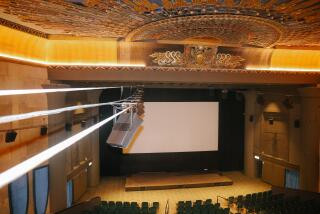An Even More Radiant ‘Beauty’
- Share via
It’s been 10 years since Jean Cocteau’s transporting 1946 “Beauty and the Beast,” as romantic a film as has ever been made, played theatrically in Los Angeles, and a lot has happened to it in the intervening decade, all of it good.
In 1995, as part of France’s celebration of the 100th anniversary of cinema, the film underwent a comprehensive restoration. Its original nitrate negative was painstakingly cleaned, sprocket holes were repaired, and missing frames--150 from 49 places in the film--were replaced.
The rejuvenated print that resulted debuts Friday for a one-week engagement at the Nuart in West Los Angeles. If you’ve never seen this timeless, magical motion picture, there couldn’t be a better opportunity. If you know the film well, you won’t need any special encouragement to see it in a version closer than anyone has a right to expect to the way it looked more than half a century ago.
Although this “Beauty” has newer, more accurate subtitles (“May the devil himself spatter you with dung” is a particularly pungent example), the prime lure is the way the print underlines the film’s incredible richness of atmosphere. Cinematographer Henri Alekan’s images are simple but crystalline, and the film’s numerous heart-stopping moments, like the magical way white curtains billow in the wind, stand out even more.
Based on the fairy tale by Jeanne-Marie Leprince de Beaumont, the story begins with Beauty (the lovely Josette Day) scrubbing floors in Cinderella fashion while her snobbish older sisters terrorize the neighborhood. Beauty has a suitor, but she is hesitant about leaving her penniless father, a merchant whose ships have a habit of not coming in.
Returning from yet another fruitless journey, Beauty’s father comes across an enchanted castle deep in the forest. He stays the night without seeing anyone, but when he stops to pick a rose for Beauty, the magnificent Beast appears. “You may take anything but my roses,” he announces with the magisterial clarity that characterizes Cocteau’s script. “For this you must die.”
Jean Marais, a lover and protege of Cocteau’s, plays the Beast as a figure of enormous dignity. Richly dressed and with an extremely realistic leonine face (created by Christian Berard and requiring hours to apply), the Beast is a picture of self-command and ironic self-knowledge. “Don’t call me ‘Sir,’ ” he says to the stunned merchant. “I am called the Beast. I do not like compliments.”
Once Beauty takes her father’s place at the castle, we see a different Beast, an ogre with a soul, crueler to himself than to humans and with a somber, heartbreaking voice that Cocteau described as that of “a monster in pain.” Tortured by a compulsion to kill that leaves his hands literally smoking, the Beast is sensitive enough to be capable of dying of a broken heart if Beauty, off to visit her dying father, does not return at the appointed hour.
Making Cocteau’s success with this material even more remarkable is that “Beauty” was filmed under extremely trying conditions. As detailed in Cocteau’s “Beauty and the Beast: Diary of a Film” (available in English translation from Dover Books), the obstacles the production had to overcome were formidable. These included an agonizing combination of flu, burns from the arc lights, and skin problems that put the director in Paris’ Pasteur Institute for a week feeling “as though my neck were being sawn through with a blunt saw.”
Always playful, Cocteau cast Marais as not only the Beast but also Beauty’s suitor, Avenant, and even the Prince who magically appears in the Beast’s place at the close, when it becomes immediately apparent that Beauty misses her more savage suitor. In this she was not alone. Greta Garbo’s reaction to the finale, or so the story goes, was equally simple and to the point: “Give me back my Beast,” she exclaimed.
*
Jean Cocteau’s “Beauty and the Beast” plays exclusively at the Nuart Theater, 11272 Santa Monica Blvd., West Los Angeles, (310) 478-6379, for a one-week run Friday through Oct. 18.
More to Read
Only good movies
Get the Indie Focus newsletter, Mark Olsen's weekly guide to the world of cinema.
You may occasionally receive promotional content from the Los Angeles Times.











